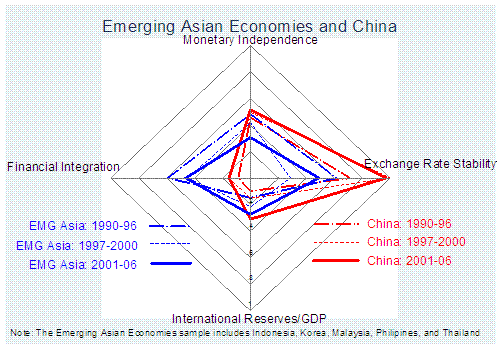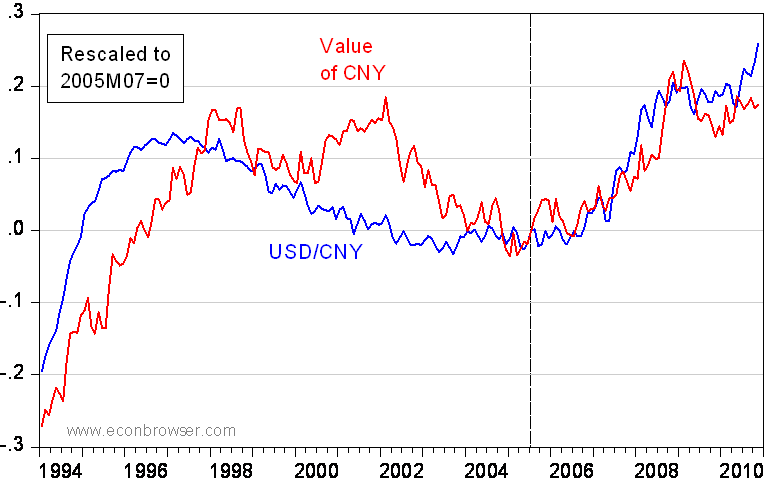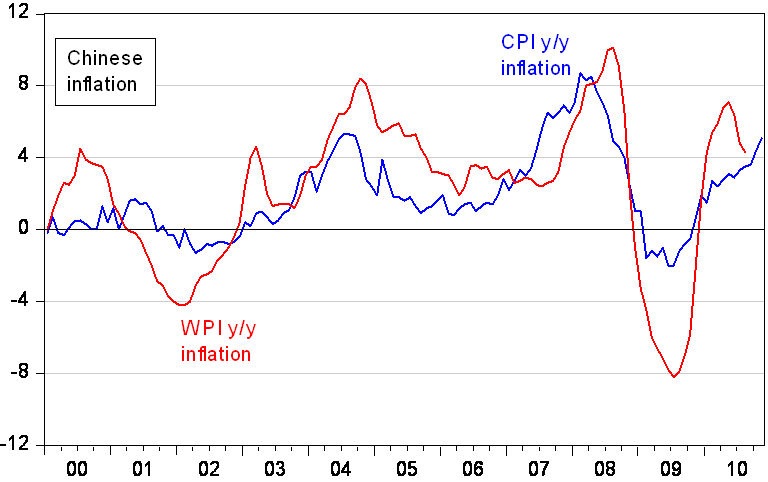I’ve just attended a conference sponsored by the Reinventing Bretton Woods Committee, entitled “The International Monetary System: Old and New Debates”, which took place against the backdrop of France’s chairmanship of the G-20.
Numerous topics were discussed, including the deficiencies of the international monetary system, externalities of international financial capital flows, multiple reserve currency regimes, and balance of payments adjustment. I was on the panel dealing with the last topic, and included Claudio Borio (BIS), Kathryn Dominguez (U. Mich.), Pier Carlo Padoan (OECD). I made the following comments:
= = =
Some lessons from recent global macro events
(Or, things I would not have thought two years ago)
- Even surplus countries can be faced with unpleasant choices (the Trilemma strikes!)
- Exchange rate adjustment can occur without nominal exchange rate changes
- Exchange rates matter for trade flows
- Difficulties in monetary/exchange rate coordination do not rule out positive outcomes.
Surplus countries eventually adjust. Certain emerging market economies have managed to run substantial and persistent current account surpluses, sometimes with the assistance of capital controls. But we see now that there are limits to the freedom afforded by these measures. Increasing monetary easing in the US combined with a desire to restrain inflation in China has presented China with a serious dilemma: allow faster nominal appreciation or allow more rapid inflation and hence real appreciation. The Trilemma strikes! (aka the “Impossible Trinity”, the fact that countries cannot simultaneously pursue monetary autonomy, fixed exchange rates, and full capital mobility) [1]

Figure 1: drawn from Figure 4 in Aizenman, Chinn, Ito (2008).

Figure 1: Log real (CPI deflated) bilateral USD/CNY (blue), and log real trade weighted value of CNY (red), rescaled to 2005M07=0. Source: St. Louis Fed FREDII, CEIC, ADB ARIC, BIS, and author’s calculations.
The fact that inflation is sufficiently high relative to other countries’ rates so as to appreciate the CNY in real terms reinforces the point that there are limits to sterilization, even in China. [FT]

Figure 2: Year-on-year CPI inflation (blue), and WPI inflation (red). Source: IMF, International Financial Statistics.
Elasticity pessimism. The variation in trade flows and real rates, especially China’s, has allowed us to get a better idea of the responsiveness of trade flows to price changes. This is particularly true where Shaghil Ahmed, as well as I, find it easy to obtain relative high price elasticities (compare [2] to [3]). Hence, there is more scope for adjustment by this path than I thought before.
There is a rejoinder that unless saving and investment determinants change, there will be no change in current account imbalances. But if the exchange rate changes are sufficiently large, they will affect those saving and investment determinants. So, it’s not an either or proposition. Rather, the elasticities, the saving-investment (or macro balances) approach and the monetary approach are all different ways of looking at the same phenomenon. [4]
A final lesson, completely unsurprising, is that coordination is very hard to achieve. But that doesn’t mean mutually beneficial sets of actions can’t occur. I think that QE2 will help convince other countries to either loosen their monetary policy (in developed countries), or ease their link to the dollar (in emerging market economies).[5] I think both of these are salutary developments.
= = =
On the issue of diplomatic versus economic success, this paragraph from the latest issue of China Economic Quarterly [not online] seems relevant:
On the current account balance, China helped organize the rejection, at the G-20 summit in Seoul in November, of a proposal by US Treasury Secretary Tim Geithner that the major economies commit to specific limits on current account balances. China’s refusal to sign anything concrete was mainly political: embarrassing the United States and undermining its ability to impose a latter-day Plaza Accord are important goals for a China that wishes to maintain maximum policy autonomy. But Beijing realizes that ever-expanding trade surpluses are politically unsustainable and will likely prompt a wave of protectionism. At the IMF’s annual meeting in October, deputy PBC governor Yi Gang indicated that China will aim to get its current account surplus below 4% of GDP within the next three to five years. The surplus this year is likely to be 5.5% of GDP, about half the 2007 peak of 10.6%; the more narrowly defined trade surplus will be about 3.8% of GDP, well down from the 2007 peak of 8.7%.
This meeting was discussed in this post.
Update, 12/19 8:49 pm Pacific. The conference summary is here [fixed 12/20]. Finance Minister Lagarde’s statement is here.
First, I think your first paragraph (Surplus countries eventually adjust.) ends rather abruptly. Did something get cut off or covered by the graph?
Second, a question that has occurred to my naturally contrarian mind as I read this post and others is, “If China’s fixed exchange rate and trade surplus with the United States is driving inflation in China is the reverse true as well? Are these policies behind the deflationary pressures being felt in the United Staes?”
Nice post.
Important caveat: IOER may undermine the recent US effort to ease.
But ultimately we all need to take a big international breath and relax (chill out!). China will respond to the US because it has no choice. (China must tighten in response.) In Macro the big fish always takes the lead. When China has its day things will of course change.
One has to assume that the good principles of usury will prevail.The good usurers have always been willing to preserve the health of their debtors, when the debtors have always been striving to survive beyond the tenor of their debts.
These principles being casted in the marbles of civilizations,addressing the existing imbalances of the countries through G20, is still civilization.
The medium of trade exchange,the currencies exchange rates and their underlying responding assets have to be included to the subject.
Through
“Evidence on Financial globalization and crisis Global imbalances M Chinn” chart P5 is explicitly showing the evolution of current accounts through time, for many countries the correlation between exchange rates and trade is very weak, see Econbrowser “”Arguments against QE2” see “Prospects for Growth And Rebalancing”
As for the euro zone,the new found solidarity among members may define the immediate priorities within constraints.The sum of the parts should drive towards balanced accounts for each of the members.
I cannot refrain to remember after “Love in the time of cholera” G Marquez wrote ” One hundred years of solitude”
Let me preface this by saying I am a huge fan of Professor Chinn’s and this blog….. and also I have a love/hate relationship with China (But I think a fair relationship). I really respect Professor Chinn’s thoughts on American inflation….. NOnetheless……. Figure one is a 3-dimensional (3-D) graph above……. You need a real way to present a 3-D graph and not one dimensional way to present 3d——–IT’S SLOPPY!!! Professor China, you wouldn’t except such a poorly presented graph from your own students, correct this and show us you are human
Menzie,
You (and 2slugs) correctly pointed out to me that the CBO uses current law and does not take dynamics into consideration when making predictions. But that missed my point. Let’s start with some economic truths. The govt sells treasury securities to cover deficit spending. Treasury securities are listed as assets on private sector balance sheets. A U.S. Savings bond is a Treasury Security. Treasury securities are govt debt. Treasury Securities are private sector savings. (hence the name SAVINGS bond and listed as assets). The debt/gdp ratio can be restated Treasury security/gdp ratio which can be restated private sector savings/gdp ratio (I am assuming mathematical substitution is still allowed – it’s been 30 years since I took a math class). So the CBO predicted that the savings ratio of the private sector was going to fall to a post war record low at the same time the baby boom generation was reaching a max point of starting retirement. My guess is the savings ratio would have reached a record high, after all, people do want to save for retirement. I wasn’t faulting the CBO method, just their understanding of macroeconomics. And they have proven themselves to have no credibility in that manner.
markg I’ll confess to being unsure if I’m entirely following your argument, but it sounds to me like you are confusing stocks and flows. The saving rate is a flow variable; accumulated savings in the form of bonds (i.e., as wealth) is a stock variable.
Menzie,
the link to the conference agenda is broken. Can you fix it, please?
thanks!
2slugbaits,
I did not say savings rate; I said savings ratio. Much like the debt/gdp ratio is the acumulated debt compared to the level of gdp, I was just substituting accumulated savings in place of accumulated debt. I guess I should have been more specific in defining savings to mean net financial wealth. So do you think accumulated net financial wealth (what I called savings) would reach a record low as the baby boomers were getting ready to retire? The CBO did!
C Meissner: Sorry about the broken link. Now fixed!
thoughtful
one reason long term surplus countries eventually adjust
is the major international creditors, a completely coincident group, always lose eventually on their foreign investments.
This is according to HODGES IRON LAW OF INTERNATIONAL FINANCE
the reason its a law is because low/no yields at home force them out into unfamiliar international areas
the reason its an iron law is if they get lucky or skilled for a while that throws the system even more out of equilibrium.
this has held ever since Spain in the 16th–17th century,
england in the 19th,
OPEC and Japan in the 20th